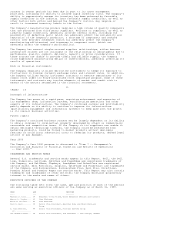Dell 1998 Annual Report Download - page 20
Download and view the complete annual report
Please find page 20 of the 1998 Dell annual report below. You can navigate through the pages in the report by either clicking on the pages listed below, or by using the keyword search tool below to find specific information within the annual report.MARKET RISK
The Company is exposed to a variety of risks, including foreign currency
exchange rate fluctuations and changes in the market value of its investments.
In the normal course of business, the Company employs established policies and
procedures to manage these risks.
Foreign Currency Hedging Activities
The Company's objective in managing its exposure to foreign currency exchange
rate fluctuations is to reduce the impact of adverse fluctuations in earnings
and cash flows associated with foreign currency exchange rate changes.
Accordingly, the Company utilizes foreign currency option contracts and forward
contracts to hedge its exposure on anticipated transactions and firm commitments
in most of the foreign countries in which the Company operates. The principal
currencies hedged during fiscal year 1999 were the British pound, Japanese yen,
German mark, French franc and Canadian dollar. The Company monitors its foreign
currency exchange exposures daily to ensure the overall effectiveness of its
foreign currency hedge positions. However, there can be no assurance the
Company's foreign currency hedging activities will substantially offset the
impact of fluctuations in currency exchange rates on its results of operations
and financial position.
Based on the Company's foreign currency exchange instruments outstanding at
January 29, 1999, the Company estimates a maximum potential one-day loss in fair
value of approximately $12 million, using a Value-at-Risk ("VAR") model. The VAR
model estimates were made assuming normal market conditions and a 95% confidence
level. The Company used a Monte Carlo simulation type model that valued its
foreign currency instruments against a thousand randomly generated market price
paths. Anticipated transactions, firm commitments, receivables and accounts
payable denominated in foreign currencies were excluded from the model. The VAR
model is a risk estimation tool, and as such is not intended to represent actual
losses in fair value that will be incurred by the Company. Additionally, as the
Company utilizes foreign currency instruments for hedging anticipated and firmly
committed transactions, a loss in fair value for those instruments is generally
offset by increases in the value of the underlying exposure. Foreign currency
fluctuations did not have a material impact on the Company's results of
operations and financial position during fiscal years 1999, 1998 and 1997.
Euro Conversion
The Company has evaluated the potential impact of the Euro conversion on the
Company. The Company identified issues related to the Euro conversion, including
issues related to information systems and business processes, and assessed the
effect on the Company's results of operations and financial position. Also, the
Company introduced www.euro.dell.com to provide the latest information on the
Company's Euro initiatives, as well as to provide basic tools to assist the
Company's customers in dealing with the Euro conversion. There can be no
assurance that all issues related to the Euro conversion have been identified
and that any issues will not have a material effect on the Company's results of
operations or financial position. However, the Company believes that it has and
will continue to take appropriate steps to assess and address Euro conversion
issues and currently does not expect that its business will be adversely
affected by such conversion in any material respect.
24
<PAGE> 26
Marketable Securities
The fair value of the Company's investments in marketable securities at January
29, 1999, was approximately $3 billion. The Company's investment policy is to
manage its marketable securities portfolio to preserve principal and liquidity
while maximizing the return on the investment portfolio through the full
investment of available funds. The Company diversifies the marketable securities
portfolio by investing in multiple types of investment-grade securities and
through the use of different investment brokers. The Company's marketable
securities portfolio is primarily invested in short-term securities with at
least an investment grade rating to minimize interest rate and credit risk as
well as to provide for an immediate source of funds. Based on the Company's
marketable securities portfolio and interest rates at January 29, 1999, a 175
basis point increase or decrease in interest rates would result in a decrease or
increase of $25 million, respectively, in the fair value of the marketable
securities portfolio. Changes in interest rates may affect the fair value of the
marketable securities portfolio; however, such gains or losses would not be
realized unless the investments are sold.
FACTORS AFFECTING THE COMPANY'S BUSINESS AND PROSPECTS
There are numerous factors that affect the Company's business and the results of
its operations. These factors include general economic and business conditions;
the level of demand for personal computers; the level and intensity of
competition in the computer industry and the pricing pressures that may result;
the ability of the Company to timely and effectively manage periodic product
transitions, as well as component availability; the ability of the Company to
develop new products based on new or evolving technology and the market's
























